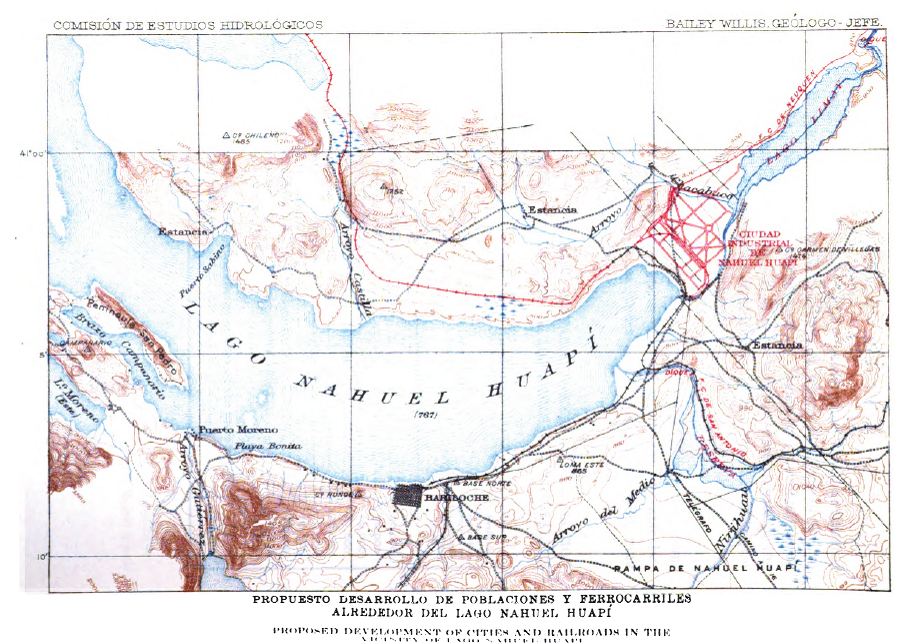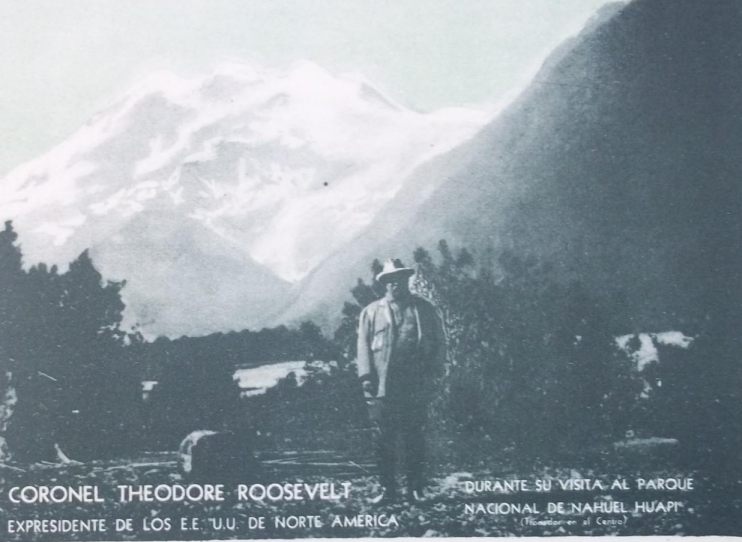Nahuel Huapi National Park in Argentina protects the Nahuel Huapi lake, which winds through the alpine peaks and glaciated expanses between the national border with Chile and the surroundings of the town of San Carlos de Bariloche. Borne out of a blurred boundary between private and public initiatives, the park has an unusual origin story: the land donated by the scientist Francisco P. Moreno to the nation to form the park had been earned exploring the region on behalf of the government. Moreno made the donation in a letter dated 6 September 1903, although the park did not gain official national park status—as the “National Park of the South”—until 1922.

View of Nahuel Huapi Lake including the town of San Carlos de Bariloche, islands within the lake, and the Andean cordillera in the background.
View of Nahuel Huapi Lake including the town of San Carlos de Bariloche, islands within the lake, and the Andean cordillera in the background.
Photo taken by Emily Wakild (2011).
 This work is licensed under a Creative Commons Attribution-NonCommercial-ShareAlike 4.0 International License.
This work is licensed under a Creative Commons Attribution-NonCommercial-ShareAlike 4.0 International License.
Moreno played a large role shaping the park; his ideas were in turn shaped by his relationships with others. His vision for a park drew upon and expanded ideas about parks in the Americas, and intended to conserve the northern Patagonian landscape creating a site for recreation and scientific study. Moreno did not work alone or ignore other influences in the territory: he recognized the longstanding communities of Mapuche and Tehuelche peoples. Indeed, they had assisted him in his earlier expeditions and also prevented him from crossing the Andes into Chile. Such complex relationships earned native peoples Moreno’s respect if not a full place in planning the future of the park.
Moreno’s idea for a park formed part of his vision for the whole region. He hoped the park’s scenery would attract people from Buenos Aires. This hope was realized over the subsequent decades of development and with the construction, since 1911, of a train route to the coast. Settlers arrived with plans to develop ranches, orchards, and even ski resorts. Moreno’s vision privileged scenery but as ranchers and immigrants arrived, they began exploiting resources more comprehensively.

Sketch map of proposed industrial city at Nahuel Huapi planned with arrival of railroad.
Sketch map of proposed industrial city at Nahuel Huapi planned with arrival of railroad.
Bailey Willis, Northern Patagonia Character and Resources. Edited by Bureau of Railways Ministry of Public Works. Vol. 1. Buenos Aires: Comisión de estudios hidrológicos/ Scribner Press, New York, 1914.
 This work is licensed under a Creative Commons Attribution-NonCommercial-ShareAlike 4.0 International License.
This work is licensed under a Creative Commons Attribution-NonCommercial-ShareAlike 4.0 International License.

Brochure of Nahuel Huapi National Park with Theodore Roosevelt standing on the shores of the lake. Photograph taken during his visit to the park in 1913 as a guest of Francisco Moreno.
Brochure of Nahuel Huapi National Park with Theodore Roosevelt standing on the shores of the lake. Photograph taken during his visit to the park in 1913 as a guest of Francisco Moreno.
Creator: Unknown.
Brochure likely produced in the 1930s.
Courtesy of NARA, Record Group 79, Entry 10: Central Classified Files, 1907-49, Box 2913, Folder: “Proposed Foreign Parks, Argentina, 1934-47,” p115.
 This work is licensed under a Creative Commons Public Domain Mark 1.0 License.
This work is licensed under a Creative Commons Public Domain Mark 1.0 License.
Natural zones and settlements developed in and around the park across fluid boundaries. The park was only one important feature in a multifaceted landscape. It was not always clear where the park ended and another use began. The coexistence of these competing visions of scenery, resource use, and daily life help account for the five strict natural reserve zones within and the three municipalities directly adjacent to the park today. Unhurried glaciers, crystalline lakes and rivers, abundant waterfalls, and varied humid and dry woodlands continue to draw visitors from across the arid steppe to this Andean oasis.
As the oldest park in South America, Nahuel Huapi served as a reference, a landmark, and a source of pride for proponents of other parks. Former United States president Teddy Roosevelt visited the future park area in 1913. Chile’s second and now oldest park, Vicente Pérez Rosales, was created adjacent to Nahuel Huapi in 1926. In 1968, the first conference on Latin American conservation, sponsored by the International Union for the Conservation of Nature, took place here. Nahuel Huapi helps us to understand Latin American nature conservation because it served as a model and template for others.
How to cite
Wakild, Emily. “Blurring Boundaries: Nahuel Huapi National Park.” Environment & Society Portal, Arcadia (2015), no. 5. Rachel Carson Center for Environment and Society. https://doi.org/10.5282/rcc/6915.
ISSN 2199-3408
Environment & Society Portal, Arcadia
 This work is licensed under a Creative Commons Attribution-NonCommercial-ShareAlike 4.0 International License.
This work is licensed under a Creative Commons Attribution-NonCommercial-ShareAlike 4.0 International License.
2015 Emily Wakild
This refers only to the text and does not include any image rights.
Please click on the images to view their individual rights status.
- Bustillo, Ezequiel. El despertar de Bariloche. 2nd ed. Buenos Aires: Casa Pardo, 1971.
- Moreno , Francisco P. Viaje a la Patagonia Austral, 1876–1877. Buenos Aires: La Nación, 1879.
- Moss, Chris. Patagonia: A Cultural History. New York: Oxford University Press, 2008.








